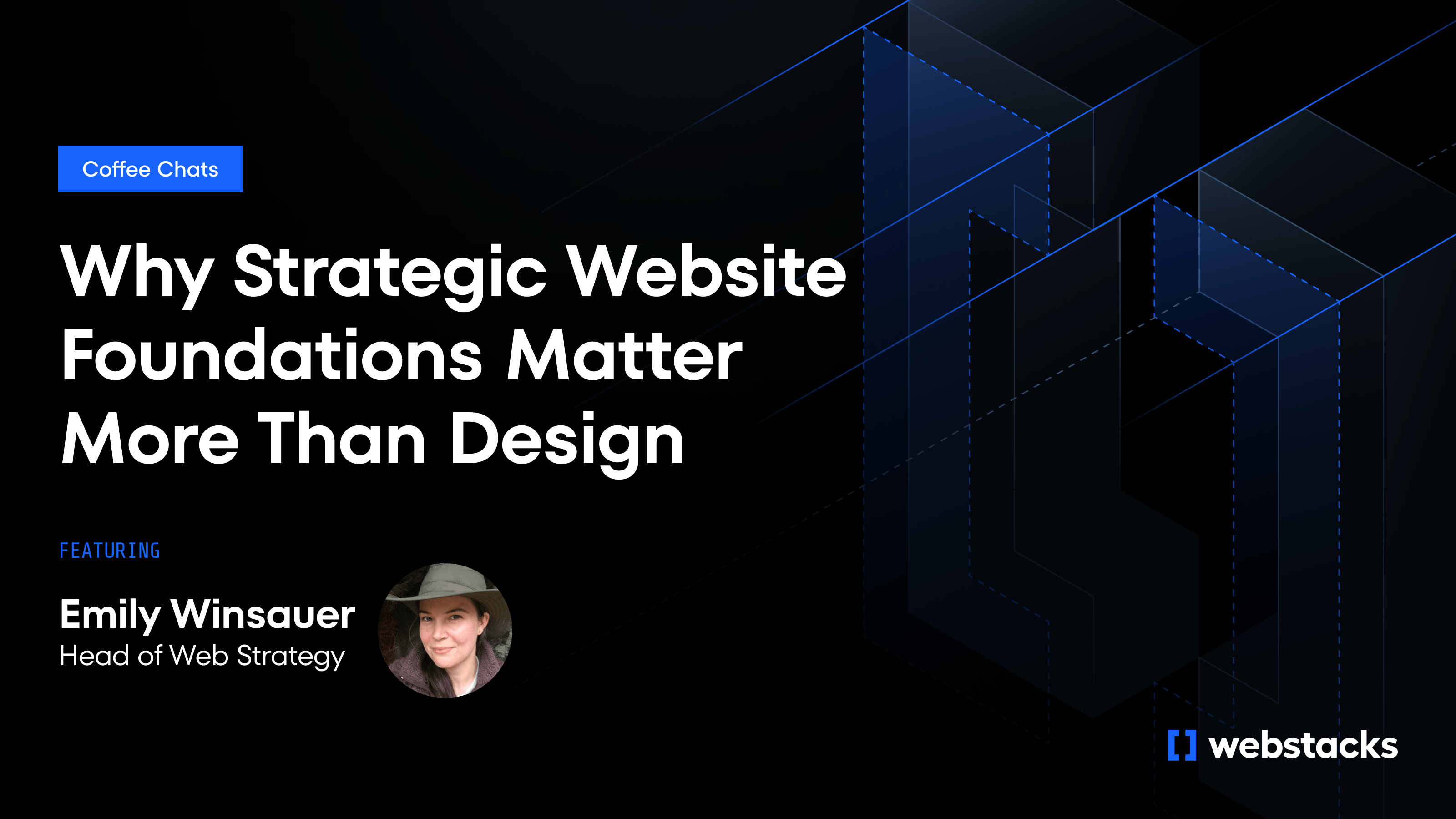Picture this: your next big campaign is ready, but a simple website update gets stuck in the developer queue. Time ticks by and the opportunity fades.
This is the reality for B2B marketing teams relying on traditional content systems, which are slow, manual, and frustratingly rigid.
But there’s a new way forward. Composable content flips the script by using modular, reusable blocks. Launching a tailored campaign or updating product messaging everywhere becomes fast and easy, without developer bottlenecks.
With composable website content, your team gets the tools and freedom to move at the speed of the market. The results are fewer delays, smarter personalization, and a content engine built to keep pace with your ambitions.

What is Composable Content?
Composable content refers to creating digital content as reusable components that can be assembled and delivered across multiple digital experiences, channels, and platforms. This content architecture focuses on flexibility, reusability, and interoperability.
Headlines, CTAs, feature descriptions and product details are all designed to be dynamically assembled for various use cases rather than locked into fixed presentations.
This approach differs from static content strategies where content is tightly connected with presentation. Composable content remains flexible, making it perfect for omnichannel strategies and personalization at scale.
Consider these practical applications:
- Hero messaging becomes a reusable component with interchangeable headline, subheadline, and image fields. It allows rapid deployment of on-brand messaging while customizing specific elements for each page or campaign.
- Customer testimonials structured as modular components with attributes like industry, company size, or use case can dynamically swap to show the most relevant social proof for different audience segments.
- Product descriptions designed as modular feature components can render differently based on visitor profiles, showcasing benefits that resonate most with specific user types.
- For global brands, composable content allows mixing localized components with globally consistent elements. It streamlines localization without creating duplicate pages for each market.
Why B2B Teams Are Moving Toward Composable Content
B2B marketing teams adopt composable content to solve their biggest workflow challenges:
Faster Campaigns with Composable Content
With a library of ready-to-use content blocks, you can quickly assemble new pages without starting from scratch. You can respond to market changes and customer needs in days, not months.
Composable content helps you eliminate unnecessary steps, much like how process optimization eliminates unnecessary testing.
Marketing Independence
Composable content lets marketing and technical teams work in parallel. You can build and publish content, and avoid waiting in the developer queue. Thanks to reduced IT dependency for routine content updates, you can launch a campaign at the exact time you envisioned.
Brand Control
When you have complex product offerings, keeping messaging consistent across channels is hard. Composable content centralizes your approved messaging and brand elements in reusable blocks.
Your brand stays consistent whether content appears on your website, in emails, or in sales materials.
Scalability
As you grow across product lines or regions, composable content provides structure that scales without fragmentation.
The impact is clear. Teams using composable content launch new campaigns faster and see a significant boost in how often they can repurpose content across different projects and channels.
How is Composable Content Different from a Headless CMS?
Composable content and headless CMS solve different problems in your content strategy.
A headless CMS separates content from presentation, delivering it via APIs to any front-end or device. It gives you flexibility in where content appears, but doesn't automatically make the content itself more reusable.
You can use a headless CMS without a composable approach. Many organizations implement headless systems but still create page-centric content lacking true modularity.
Composable content is a solution to this problem. It focuses on how you structure and organize content, and this modularity exists regardless of your delivery method.
But composability can go further and focus on internal organization and relationships. A product description can be easily reused across your website, mobile app, and email campaign without duplicating or reformatting it for each channel.
The most powerful approach combines both concepts. The headless CMS provides flexible delivery, while the composable approach structures your content for maximum reusability. This combination gives you content scalability and team flexibility, allowing you to create once and publish everywhere.
What Composable Content Looks Like in Practice
Composable content transforms how B2B teams work in measurable ways.
Demand generation teams can build personalized landing pages in hours by assembling pre-approved content blocks with targeted messaging. The quick deployment allows them to test more variations and respond faster to performance data.
Product marketers can create feature descriptions once and reuse them across different vertical markets or pricing tiers. The core messaging stays consistent, while still allowing customization for specific segments.
Localization becomes simpler, as teams translate only what needs to be different while reusing shared components. It saves on translation costs and helps launch global campaigns faster.
Design and development teams can also use shared components across multiple brands without rebuilding design systems.
How to Start Using Composable Content
You can transform your content approach with these practical steps:
1. Audit Your Content
Look at your existing content to find elements you frequently reuse across pages or channels. Common candidates include call-to-action buttons, product feature descriptions, customer testimonials, headers and footers, and pricing tables.
Start with high-impact, frequently used components that will deliver immediate value when modularized.
2. Define a Modular Content Model
Break your identified components into discrete fields with clear relationships. For a product description, this might include product name, short description, full description, and key features (as a list). Technical specifications and associated images are also common.
3. Select an Appropriate CMS Platform
Choose technology that aligns with your requirements. Look for flexible content modeling, an API-first approach for seamless headless delivery, and robust governance features with granular user permissions.
Options include Contentful, Storyblok, Sanity, Hygraph, and Strapi.
4. Create a System, Not Just Components
Establish a clear system by giving your content parts consistent names and adding useful tags to make searching easier. Define simple usage rules and set up straightforward steps to keep everything well-organized and high-quality.
Webstacks took this approach with Workgrid, building a reusable design system and structured component library that gave their team the ability to launch and scale content quickly.
5. Train Your Teams
Success requires everyone understanding the new approach. Show content creators how working with modular content improves their workflow, and help designers create flexible components for reuse.
Start with small cross-functional teams responsible for high-priority content areas, then expand as you demonstrate success.

Tools That Support Composable Content
You'll need the right technology stack to implement composable content across these key categories:
Headless CMS Platforms (Content Modeling + Delivery)
These platforms are the foundation of your composable content strategy:
- Contentful is great at creating structured content blocks through powerful content modeling features. Its API-first approach makes it ideal for delivering content across multiple channels, with organizations like Atlassian and Spotify using it to scale their content operations.
- Storyblok offers a visual editor combining headless flexibility with traditional CMS ease of use. Its component-based architecture aligns with composable content principles, making it accessible to marketing teams without sacrificing developer flexibility.
- Sanity provides a customizable content studio suited for complex content structures and collaborative workflows. Companies like Nike and National Geographic use Sanity for its flexibility in modeling structured content.
- Hygraph (formerly GraphCMS) uses GraphQL for content delivery, offering a flexible approach particularly useful for projects requiring complex content relationships and federated content from multiple sources.
- Strapi is an open-source headless CMS with a user-friendly admin panel that gives teams extensive customization options. It is ideal for organizations that want more control over their CMS infrastructure.
When evaluating these platforms, look for flexible content modeling, strong API capabilities, and support for content relationships.
Frontend Frameworks (Rendering Composable Content)
These frameworks assemble and deliver your composable content:
- Next.js excels at server-side rendering and static site generation within the React ecosystem. Its dynamic import capabilities make it ideal for assembling modular content, with companies like Netflix and TikTok using it for content-heavy applications.
- Nuxt.js offers similar capabilities for Vue.js developers, with powerful features for creating content-driven applications with excellent performance.
- Remix focuses on server-side rendering and nested routing, which are particularly useful for creating content-heavy applications with optimal loading performance.
These frameworks help developers create fast applications that dynamically assemble your composable content.
Design Systems and Component Libraries
These tools support consistency in how your composable content is presented:
- Storybook helps develop UI components in isolation, creating and documenting reusable components that align with your composable content strategy.
- Figma bridges design and development with its component-based approach and developer handoff features, creating design systems that mirror your composable content structure.
- Chromatic integrates with Storybook for visual testing.
Success with composable content comes from creating an ecosystem of tools working together. Start by identifying where you need the most flexibility and scalability, then build your toolkit around those core requirements.
What to Watch Out For
As you implement composable content, watch for these common challenges:
Content Fragmentation
Modular content creates complex relationships between content pieces that can become fragmented without proper management.
Prevent this by:
- Setting up governance policies to maintain content integrity
- Using clear naming conventions and metadata for easy discovery
- Regularly auditing your content library
Over-Engineering Too Early
Many teams try to modularize everything at once, creating unnecessary complexity.
Take a measured approach:
- Start with high-impact components you reuse often
- Implement in phases, gradually expanding your modular structure
- Regularly reassess your content model to keep it practical
Cross-Team Alignment
Composable content requires buy-in across marketing, design, development, and product teams.
Foster collaboration by:
- Holding regular cross-functional working sessions
- Creating shared documentation and style guides
- Training all teams on composable content benefits and practices
Technology Integration Challenges
Integrating various tools can be complex.
Smooth this process by:
- Evaluating your tech stack for compatibility with composable principles
- Planning for data migration and content restructuring early
- Considering integration specialists for complex ecosystems
Maintaining Flexibility While Scaling
As your content library grows, keeping it flexible becomes harder. A structured approach helps:
- Reviewing and refining your content models regularly
- Implementing version control for content components
- Creating clear processes for introducing new content types
Addressing these challenges head-on ensures your composable content system works for you. Build a system that fits your marketing team's real needs and frees their creativity rather than creating more hoops to jump through.
Build for Reuse, Not Rebuilds
Composable content helps your B2B team work faster and maintain brand consistency. Instead of creating everything from scratch, you can quickly assemble campaigns and scale your marketing without duplicating efforts.
Modern B2B audiences expect personalized experiences that remain consistent wherever they engage with your brand. A content system delivers this balance, creating not just efficiency gains but a flexible foundation that adapts as your business evolves.
To start your journey, audit your existing content and identify repeating elements like product features, customer testimonials, and CTAs. Transform these high-value pieces first to experience immediate benefits and build a more adaptable marketing operation.
If you’re ready to implement composable content in your org, reach out to our team to get started:




